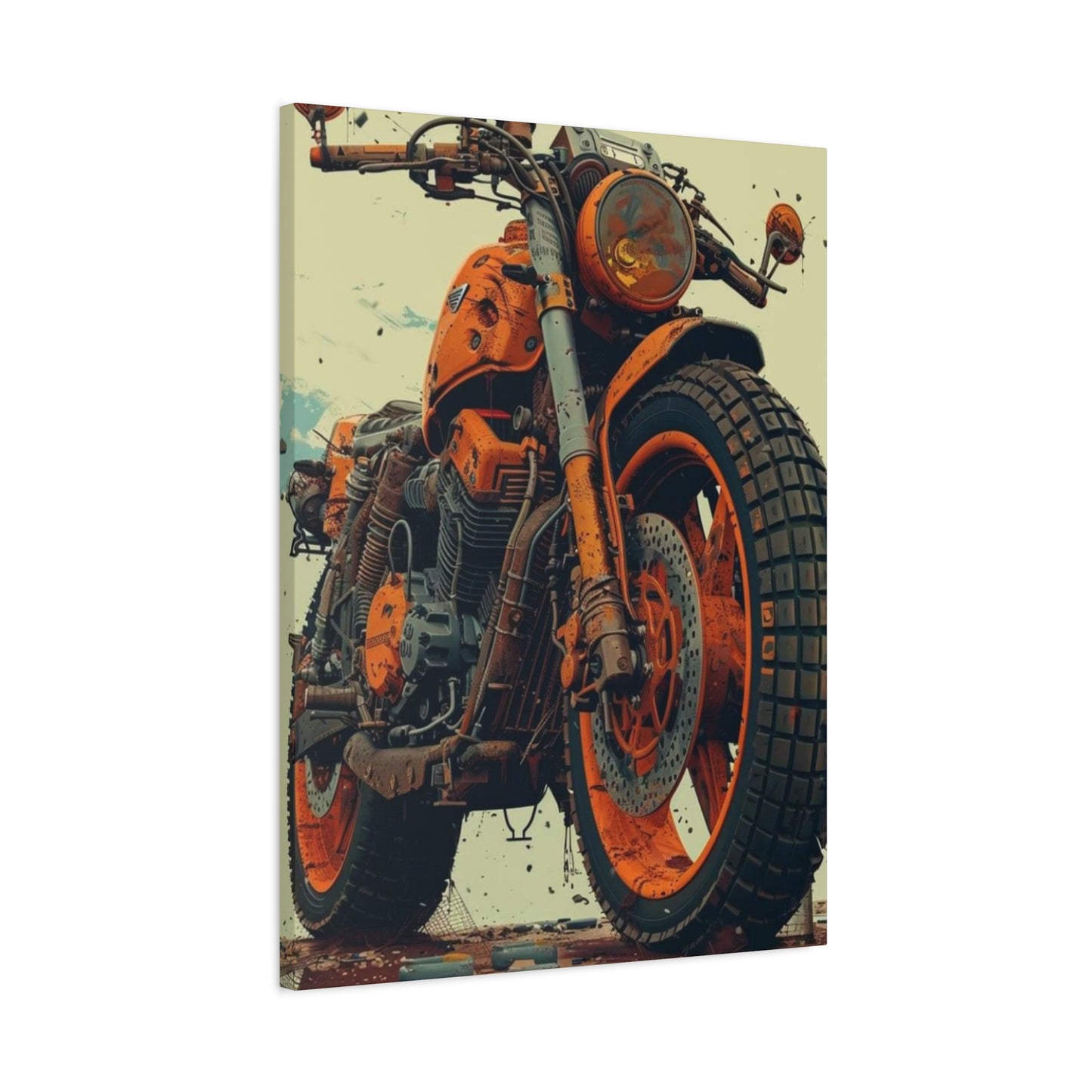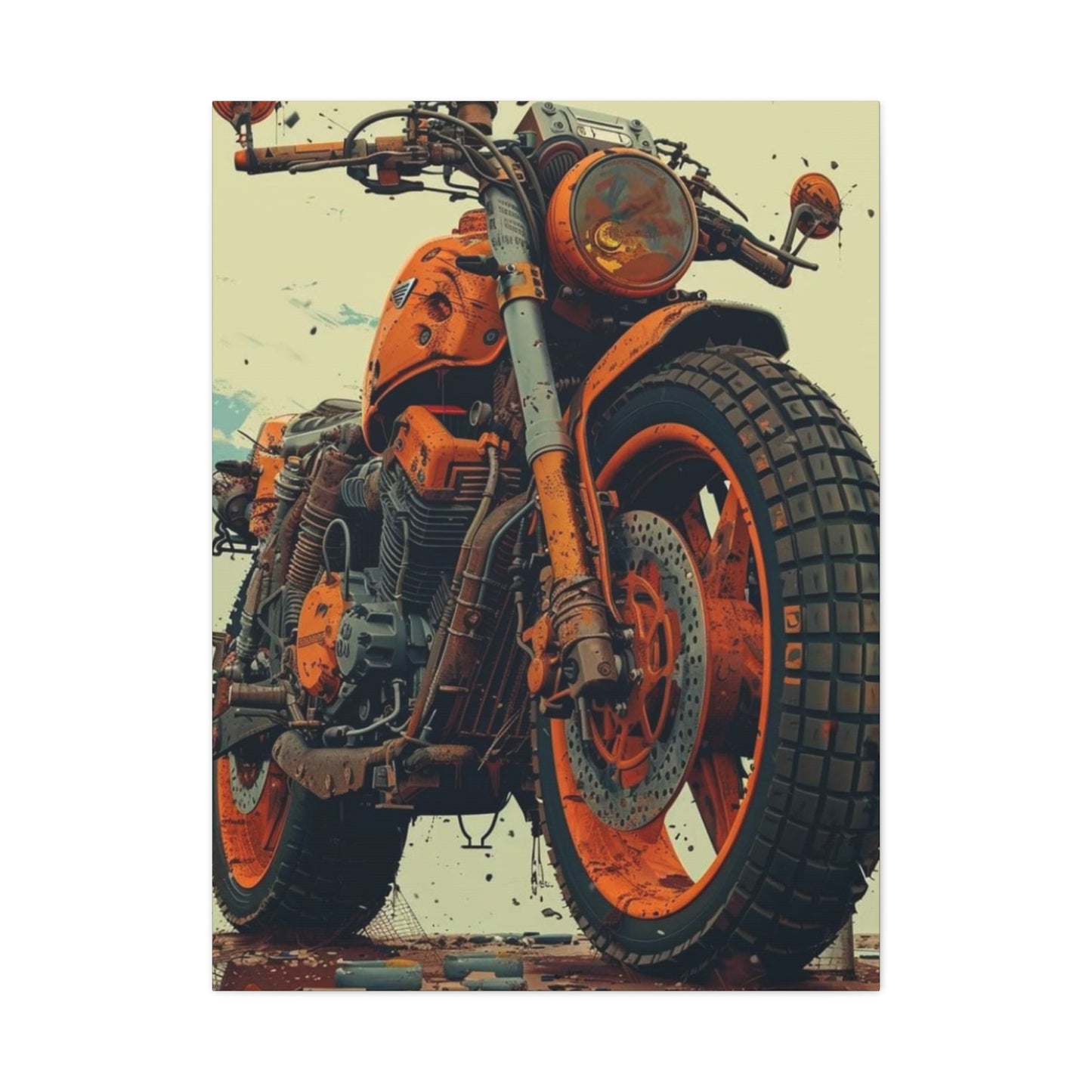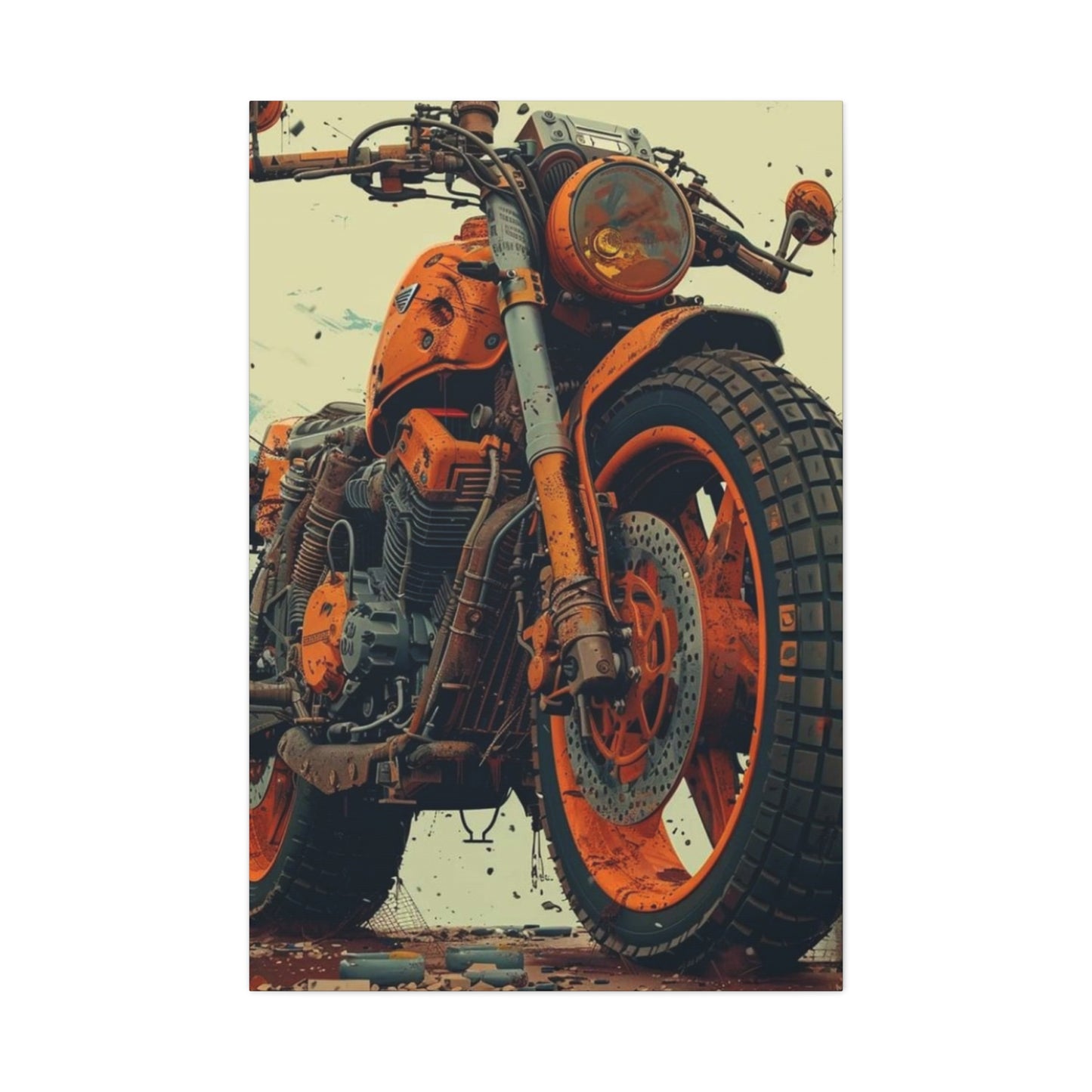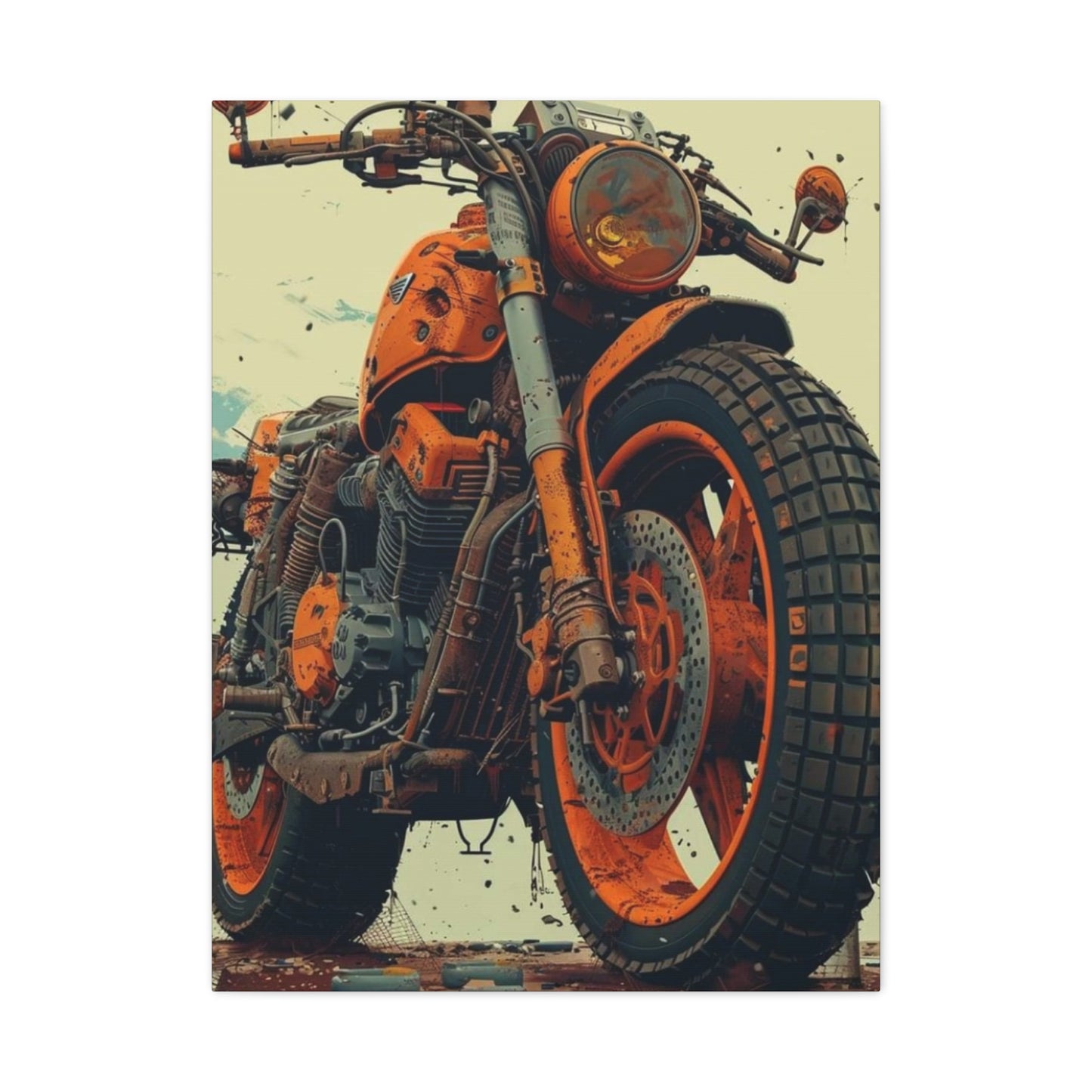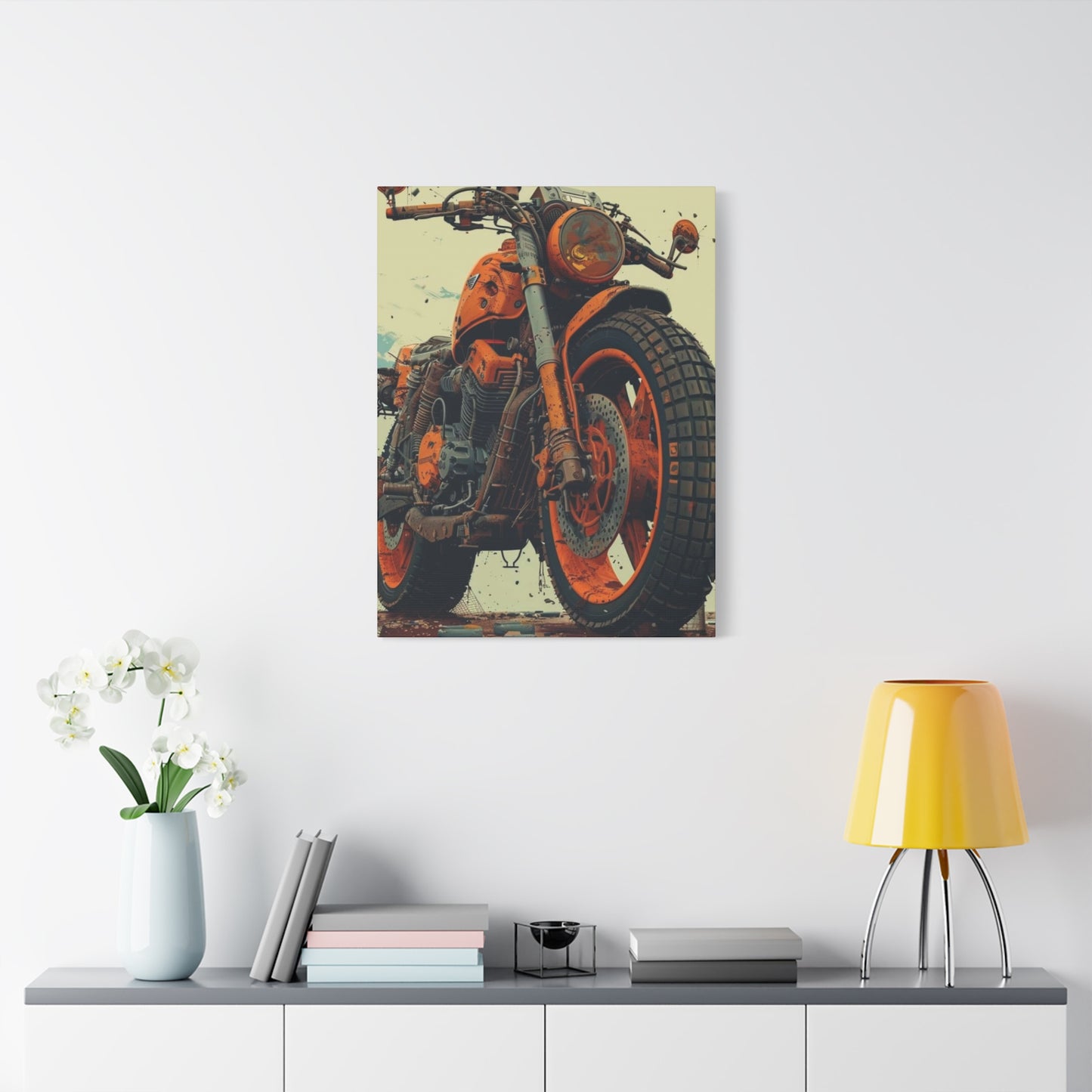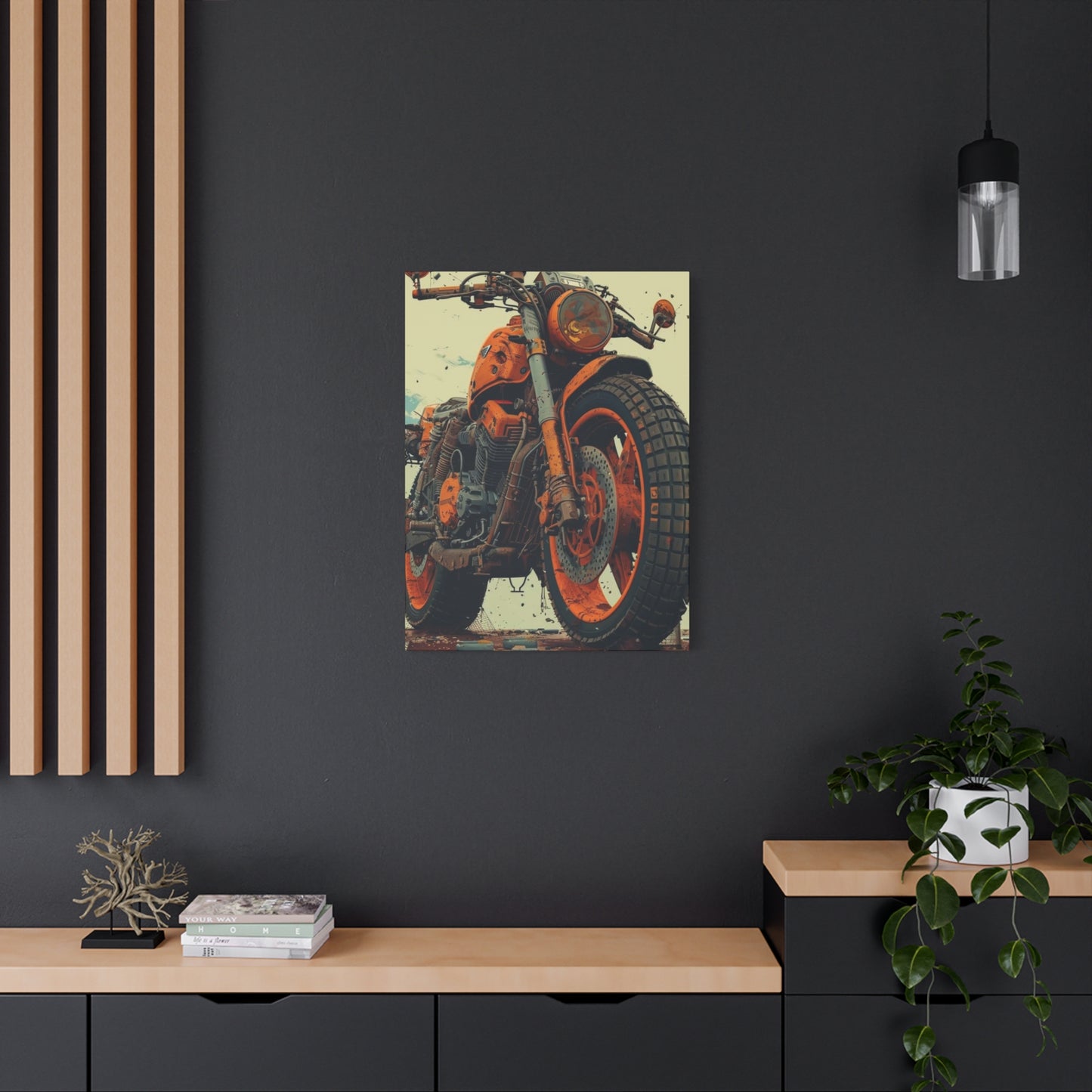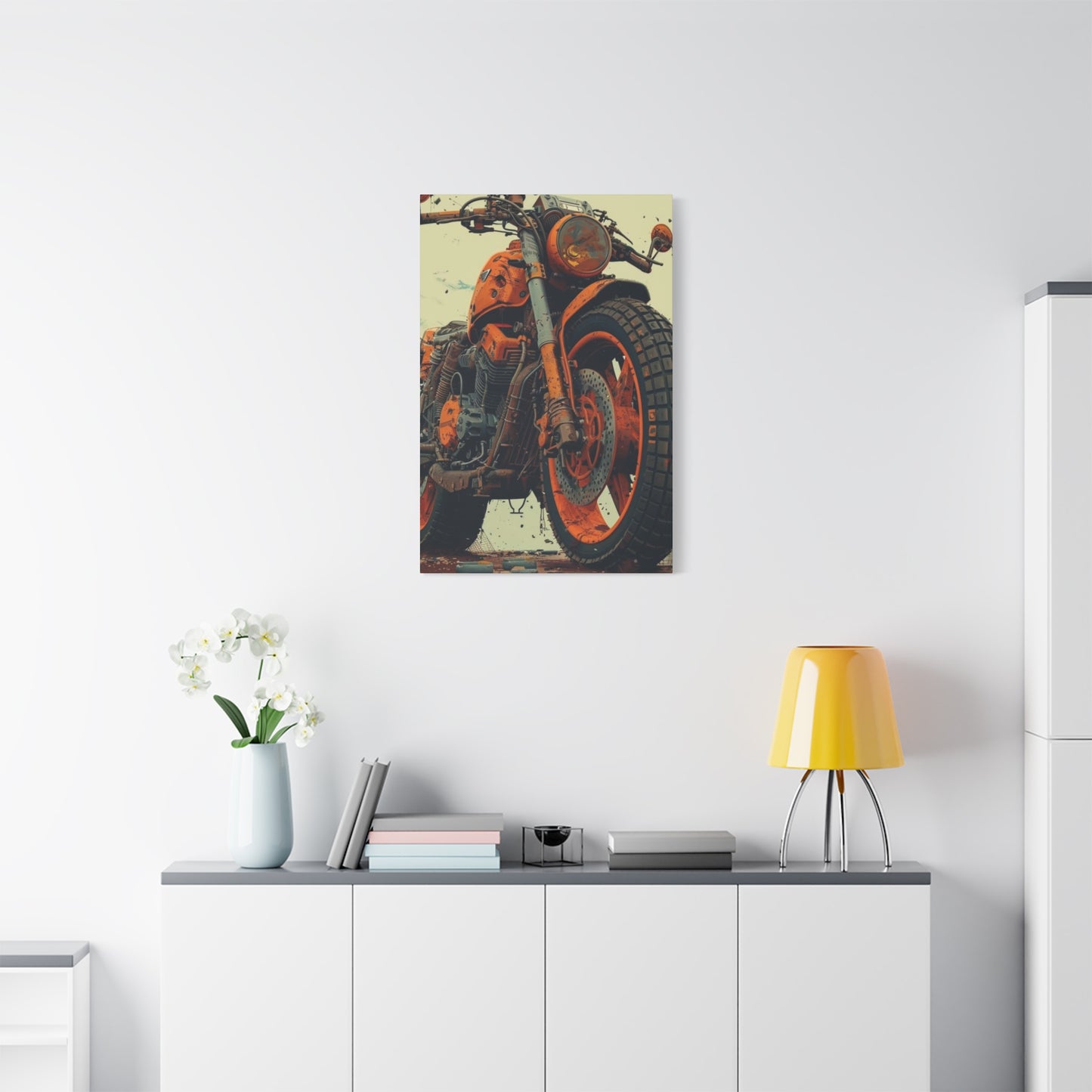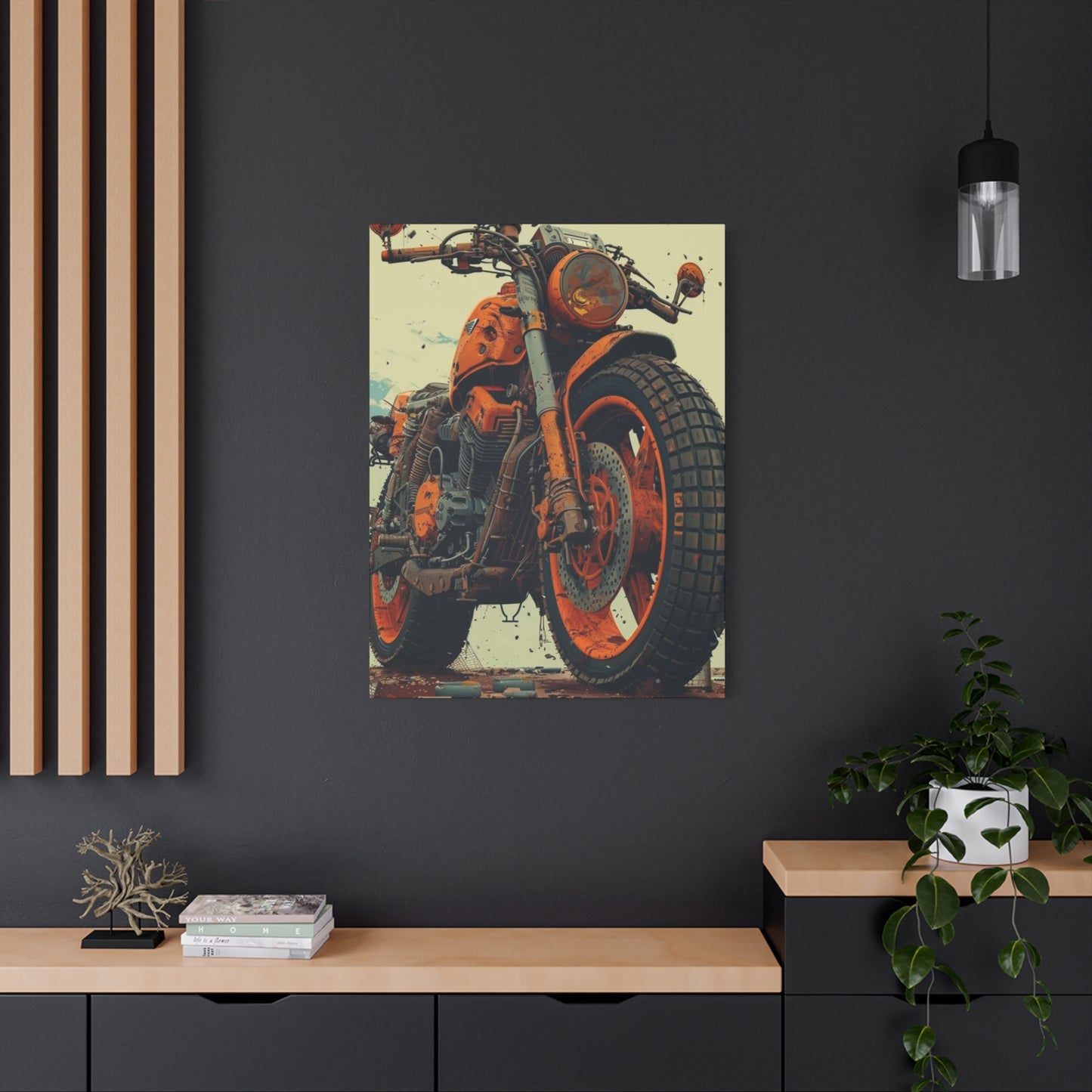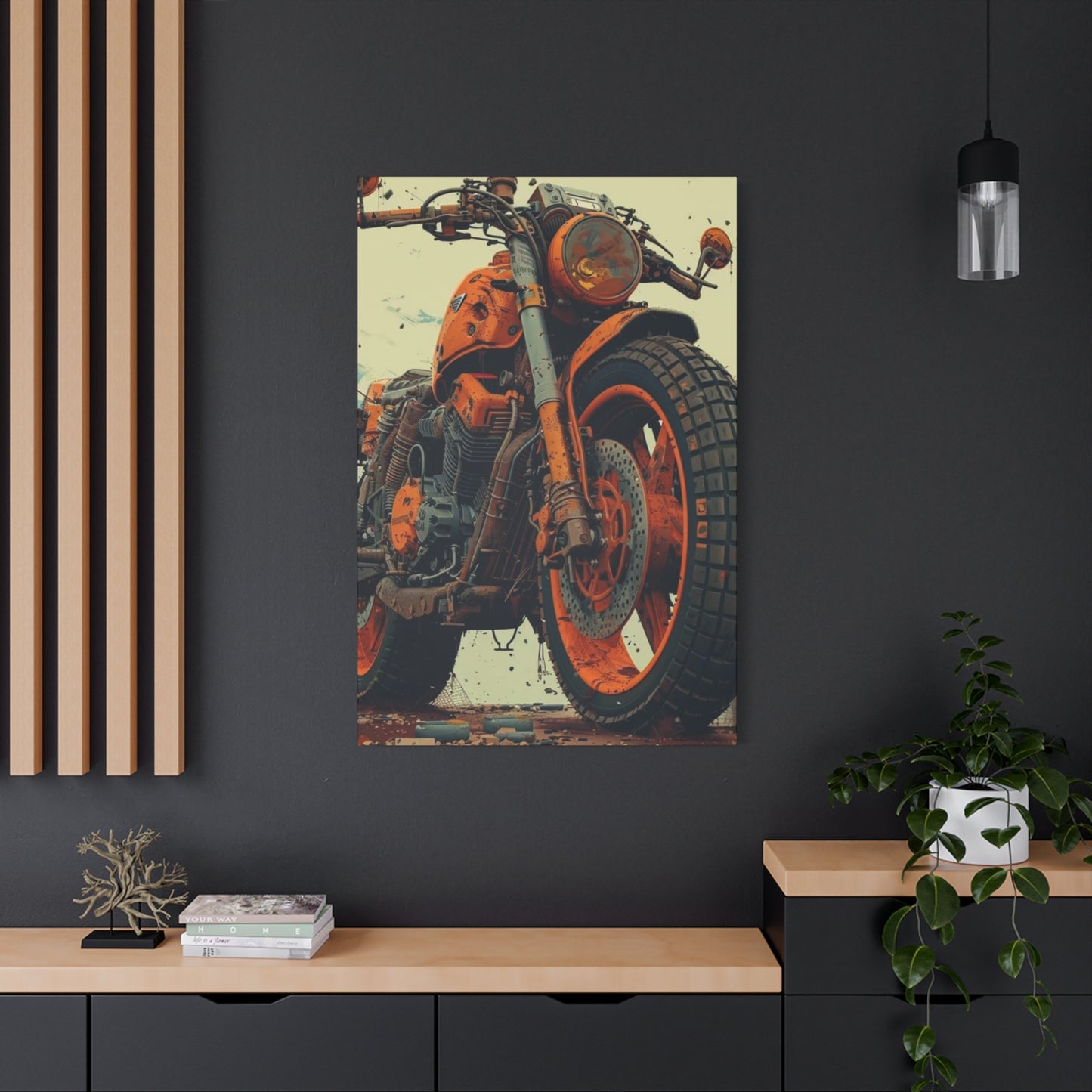Orange Poster Motorcycle Wall Art: A Rider's Expression on Your Walls
The world of motorcycle enthusiasts extends far beyond the open road. It lives in the spaces riders call home, in the garages where machines rest, and on the walls that celebrate the culture of two-wheeled freedom. Motorcycle poster art has emerged as a powerful medium for expressing passion, nostalgia, and the raw aesthetic that defines riding culture. Among the vast array of motorcycle imagery available today, orange-themed motorcycle posters have carved out a distinctive niche, capturing attention with their vibrant energy and bold visual statements.
Orange as a color carries inherent symbolism that resonates deeply with motorcycle culture. It represents enthusiasm, determination, and adventure—qualities that every rider embodies when they twist the throttle and lean into a curve. When applied to motorcycle poster art, this dynamic hue transforms ordinary wall space into a declaration of lifestyle and passion. The combination of orange motorcycles with artistic presentation creates visual pieces that speak to both the heart of a rider and the eye of an art appreciator.
This exploration delves into the multifaceted world of orange motorcycle poster art, examining how these pieces serve as more than simple decoration. They function as cultural artifacts, personal statements, and artistic expressions that bridge the gap between mechanical appreciation and aesthetic sensibility. From vintage-inspired designs to modern interpretations, from garage walls to living spaces, motorcycle poster art has evolved into an essential element of rider identity and interior expression.
Bold Orange Bike Poster
The concept of a bold orange bike poster centers on creating maximum visual impact through color choice and composition. These posters typically feature motorcycles rendered in various shades of orange—from soft tangerine to deep burnt orange—set against contrasting backgrounds that make the subject pop. The boldness comes not just from color saturation but from the confidence of the composition itself.
When designers create bold orange bike posters, they work with several visual principles simultaneously. The color orange naturally draws the human eye, sitting between red and yellow on the spectrum and combining the energy of both. In motorcycle poster design, this translates to artwork that commands attention without overwhelming a space. The boldness manifests in clean lines, strong silhouettes, and deliberate negative space that allows the motorcycle to become the undeniable focal point.
These posters often showcase motorcycles in profile view, the most recognizable angle that displays the machine's proportions and distinctive features. The profile shot has been a staple of motorcycle photography and illustration since the early days of motorbike culture, allowing viewers to appreciate the relationship between front and rear wheels, the engine's position, the seat height, and the overall stance of the bike. When executed in bold orange tones, this classic approach gains new life and contemporary relevance.
The psychological impact of bold orange bike posters extends beyond simple visual pleasure. For motorcycle owners and enthusiasts, these pieces serve as daily reminders of their passion. They create mental associations with experiences on the road—the feeling of wind resistance, the sound of an engine at full throttle, the satisfaction of a well-executed turn. In spaces where actual motorcycles cannot reside, these posters bring the spirit of riding indoors, maintaining a connection to the culture even during downtime.
Selecting the right bold orange bike poster involves considering several factors. The shade of orange matters significantly, as different tones evoke different moods. A bright, almost neon orange suggests modern sportbikes and cutting-edge performance, while deeper, rust-tinged oranges recall vintage machines and classic riding eras. The motorcycle style depicted also carries meaning—whether it's a café racer, cruiser, sportbike, or adventure bike, each speaks to different riding philosophies and aesthetic preferences.
The framing and presentation of bold orange bike posters influences their impact considerably. While some enthusiasts prefer minimalist presentations with simple black frames that let the artwork speak for itself, others opt for more elaborate framing that complements the poster's era or style. Gallery-style mounting without frames has also gained popularity, particularly for larger prints that make bold statements in modern spaces with industrial or minimalist design schemes.
Ride in Style: Wall Art
Riding in style extends beyond what happens on the road—it encompasses how riders express their passion in every aspect of their lives. Wall art serves as a permanent expression of riding culture, transforming personal spaces into reflections of identity and lifestyle. The concept of riding in style through wall art acknowledges that motorcycles represent more than transportation; they embody aesthetic choices, cultural affiliations, and personal values that deserve visual celebration.
Quality motorcycle wall art operates on multiple levels simultaneously. On the surface, it provides visual interest and decorative appeal that enhances interior spaces. More deeply, it communicates the owner's interests, experiences, and aspirations to anyone who enters the space. For riders, motorcycle wall art creates environments that feel authentic and personally meaningful, surrounding them with imagery that resonates with their lifestyle choices.
The selection process for motorcycle wall art involves balancing several considerations. Artistic quality stands paramount—wall art should demonstrate compositional skill, appropriate color theory application, and technical execution that withstands extended viewing. The subject matter must align with the owner's specific interests within motorcycle culture, whether that means vintage bikes, modern superbikes, specific manufacturers, or particular riding styles.
Scale plays a crucial role in how motorcycle wall art functions within spaces. Oversized pieces make bold statements and work particularly well in rooms with high ceilings or large expanses of blank wall space. Medium-sized works offer versatility, fitting comfortably in most residential settings while still maintaining presence. Smaller pieces work best in collections or gallery walls where multiple images create cumulative impact.
The materiality of motorcycle wall art has expanded significantly with advances in printing technology and artistic mediums. Traditional canvas prints offer texture and depth that photographs on paper cannot match, with the woven surface adding subtle dimensionality to images. Metal prints have emerged as popular choices for motorcycle imagery, with the reflective surface adding luminosity and a contemporary edge that suits modern spaces. Acrylic mounting creates depth through layering, suspending images slightly away from walls for shadow effects that enhance visual interest.
Color relationships between motorcycle wall art and surrounding décor require thoughtful consideration. Orange motorcycle imagery naturally pairs with neutral color schemes—grays, whites, blacks, and natural wood tones—that allow the artwork to stand as the primary color statement in a space. However, complementary color approaches can also succeed, with blues and teals creating dynamic tension against orange subjects, or analogous schemes using reds and yellows to create warm, cohesive environments.
The placement of motorcycle wall art influences both its visual impact and the functional use of spaces. In living areas, motorcycle art sets tones and creates conversation focal points. In home offices, it can provide inspirational imagery that motivates and energizes. In bedrooms, it personalizes intimate spaces and creates environments that reflect individual identity. In garages and workshops, it elevates utilitarian spaces into celebration areas where passion and function coexist.
Lighting considerations significantly affect how motorcycle wall art appears and functions. Natural light changes throughout the day, causing colors and details to shift in appearance. Artificial lighting can be strategically positioned to highlight artwork after dark, with track lighting, picture lights, or accent fixtures drawing attention to specific pieces. The interplay between artwork and light creates dynamic viewing experiences that evolve throughout daily cycles.
Motorcycle Aesthetic Vibes
The motorcycle aesthetic represents a complex cultural phenomenon that extends far beyond the machines themselves. It encompasses fashion, music, art, lifestyle choices, and value systems that have evolved over decades. Motorcycle aesthetic vibes in poster art capture these intangible qualities, translating the feeling of motorcycle culture into visual form that resonates with enthusiasts and appreciators alike.
Understanding motorcycle aesthetic requires recognizing its historical roots and contemporary manifestations. The aesthetic emerged in the post-war era when returning soldiers sought adventure and brotherhood through motorcycle clubs. This original aesthetic emphasized leather, chrome, and rebellion—visual elements that signaled independence from mainstream society. As motorcycle culture diversified, so did its aesthetic expressions, branching into café racer culture, custom chopper scenes, adventure riding communities, and modern sportbike enthusiasts.
Motorcycle aesthetic vibes in wall art draw from this rich heritage while adapting to contemporary sensibilities. The aesthetic might manifest as gritty, high-contrast black and white photography that emphasizes texture and shadow. It could appear as stylized illustrations that simplify motorcycles into bold graphic shapes and limited color palettes. Or it might take form as nostalgic vintage-style designs that recall early motorcycle advertising and racing posters.
The authenticity of motorcycle aesthetic vibes depends largely on understanding the culture's visual language. Certain elements consistently appear across genuine motorcycle art—the emphasis on mechanical details, the celebration of wear and patina, the inclusion of motion and speed indicators, the presence of road and landscape elements, and the subtle inclusion of rider culture symbols. Artists who successfully capture motorcycle aesthetic vibes demonstrate familiarity with these visual vocabularies.
Color palettes play significant roles in establishing motorcycle aesthetic vibes. Traditional motorcycle aesthetics favor earth tones, metallics, and muted colors that reflect the materials and environments associated with riding. Orange fits naturally into these palettes as a color historically used by several iconic motorcycle manufacturers and as a shade that appears in sunset rides, autumn touring, and desert landscapes where motorcycles often travel.
Typography and text elements contribute substantially to motorcycle aesthetic vibes in poster art. Vintage-inspired lettering styles, distressed fonts, and hand-drawn type treatments reference historical motorcycle advertising and signage. Modern interpretations might use clean sans-serif fonts that suggest contemporary design sensibilities while maintaining connection to motorcycle culture through layout choices and compositional approaches.
The relationship between motorcycle aesthetic vibes and broader design trends creates interesting tensions and opportunities. While motorcycle culture maintains strong connections to its historical roots, contemporary expressions must engage with current design languages to remain relevant and appealing. Successful motorcycle aesthetic art balances respect for tradition with awareness of contemporary visual culture, creating pieces that feel both timeless and current.
Personal connection to motorcycle aesthetic vibes varies among individuals based on their specific experiences within motorcycle culture. A rider who favors long-distance touring might respond to aesthetic elements that emphasize adventure, landscape, and endurance. Someone passionate about track riding might prefer aesthetic expressions focused on speed, precision, and performance. Custom bike builders might gravitate toward aesthetic elements that highlight craftsmanship, individuality, and mechanical artistry.
Vintage Bikes, Modern Walls
The juxtaposition of vintage motorcycles with modern wall displays creates fascinating aesthetic tensions that appeal to diverse audiences. This approach honors motorcycle history while acknowledging contemporary living spaces and design sensibilities. Vintage bikes carry stories, represent engineering eras, and embody design philosophies that differ markedly from current motorcycle manufacturing, making them compelling subjects for wall art.
Vintage motorcycle imagery offers rich visual material for artistic interpretation. The mechanical simplicity of older bikes makes their components visible and comprehensible in ways that modern, fully-faired motorcycles do not. Exposed engines, visible frames, simple fuel tanks, and minimal bodywork create clean visual lines that translate beautifully into poster art. The patina and wear that accumulate on vintage machines add texture and character that photographers and illustrators can emphasize for emotional effect.
The definition of vintage in motorcycle contexts typically refers to machines manufactured before 1975, though some extend this to include 1980s bikes as they gain classic status. These motorcycles represent an era when manufacturers built machines with distinct personalities, when different brands pursued vastly different engineering approaches, and when styling emphasized individuality over aerodynamic efficiency. This diversity provides endless subject matter for wall art.
Modern walls—the contemporary residential and commercial spaces where vintage motorcycle art hangs—present different contexts than existed during the bikes' original eras. Today's interiors often feature open floor plans, minimalist design principles, industrial materials, and neutral color schemes that provide perfect backdrops for vintage motorcycle imagery. The contrast between old subject matter and new surroundings creates visual interest and conversation opportunities.
Display techniques for vintage motorcycle art in modern spaces draw from gallery and museum practices. Clean lines, thoughtful spacing, and strategic positioning allow vintage bike imagery to function as fine art rather than simple decoration. Many collectors treat motorcycle posters with the same respect given to other collectible art forms, investing in museum-quality framing, UV-protective glazing, and professional installation.
Orange Ride, Urban Pride
The relationship between motorcycles and urban environments has evolved significantly as cities have grown and changed. Urban riding represents a distinct experience within motorcycle culture, characterized by shorter distances, frequent stops, dense traffic, and constant visual stimulation. Orange motorcycles in urban settings create striking visual contrasts, with the warm, energetic color standing out against the grays, blacks, and earth tones that dominate cityscapes.
Urban pride in motorcycle contexts refers to the sense of identity and belonging that city riders develop. Urban motorcyclists navigate unique challenges—tight parking situations, aggressive traffic, road hazards, theft concerns—that create solidarity among those who choose two wheels in metropolitan areas. The visibility of an orange motorcycle becomes a statement in urban contexts, a refusal to blend in, an assertion of individual identity within anonymous crowds.
Poster art celebrating orange rides in urban settings typically emphasizes architectural contexts. Motorcycles appear against brick walls, beneath highway overpasses, on city streets lined with buildings, or in industrial areas where urban character concentrates. These settings provide textural richness and depth that enhance the visual interest of compositions while situating motorcycles within their lived contexts.
The cultural associations of orange in urban environments add layers of meaning to motorcycle poster art. Orange appears in urban contexts as safety equipment, construction signage, and street art, creating associations with visibility, work, and creative expression. An orange motorcycle inherits these associations, becoming linked to concepts of urban exploration, street culture, and the transformation of utilitarian spaces into lifestyle venues.
Street style photography influences much contemporary urban motorcycle poster art. This approach emphasizes candid moments, authentic settings, and the documentation of real riding culture rather than staged perfection. Orange motorcycles photographed on actual city streets, with real urban contexts and sometimes real riders going about their daily routines, create authentic representations that resonate with urban riding communities.
The relationship between motorcycles and urban renewal movements provides interesting subtext for poster art. In many cities, motorcycle culture has participated in the transformation of post-industrial neighborhoods into vibrant creative districts. Motorcycle shops, cafés, and meeting spots often locate in transitional urban areas, becoming anchors for community development. Poster art documenting orange rides in these contexts captures moments of urban evolution.
Urban night riding creates particularly striking visual opportunities for orange motorcycle art. City lights, neon signs, illuminated windows, and street lamps provide dramatic lighting conditions that make orange motorcycles glow against dark surroundings. The anonymity and freedom of night riding in cities represent peak urban motorcycle experiences for many riders, making nighttime urban motorcycle imagery especially evocative.
Motorcycle Art for Gearheads
Gearhead culture represents the mechanical heart of motorcycle enthusiasm. While some riders focus primarily on the experience of riding, gearheads find equal pleasure in understanding how motorcycles function, maintaining their machines, and appreciating engineering details. Motorcycle art designed for gearheads emphasizes mechanical components, technical specifications, and the beauty of purposeful design.
The gearhead aesthetic in motorcycle poster art often features exploded views that show components separated and suspended in space, revealing how parts fit together and function as systems. These technical illustrations satisfy intellectual curiosity while creating visually compelling compositions through the arrangement of shapes, the interplay of positive and negative space, and the revelation of hidden mechanical relationships.
Close-up photography of motorcycle components serves gearhead audiences by highlighting the craftsmanship and engineering that goes into machine construction. Images focusing on engine cases, transmission assemblies, suspension components, or brake systems allow viewers to appreciate mechanical artistry separate from complete motorcycle contexts. Orange components—whether naturally colored or custom-finished—create focal points within these detailed mechanical studies.
Cutaway illustrations represent another approach that appeals to gearhead sensibilities. By showing both exterior surfaces and internal mechanical workings simultaneously, cutaway views satisfy the desire to understand how things work. These technically demanding illustrations require deep mechanical knowledge to execute accurately, making them particularly valued by knowledgeable audiences who can appreciate their accuracy and completeness.
The materials and finishes of motorcycle components fascinate gearheads and provide rich subject matter for poster art. Cast aluminum engine cases with their distinctive textures, polished stainless steel exhaust systems, painted fuel tanks with perfect clearcoat finishes, and powder-coated frames all offer distinct visual qualities. Photography and illustration that emphasize these material properties through lighting, color treatment, and compositional choices resonates with audiences who appreciate manufacturing quality.
Technical specifications and performance data sometimes appear in gearhead-focused motorcycle poster art. Displacement figures, horsepower ratings, weight specifications, and other numerical information can be integrated into designs as graphic elements that serve both informational and decorative functions. For knowledgeable viewers, these numbers tell stories about performance capabilities and engineering approaches.
The evolution of motorcycle technology over time provides narrative opportunities for gearhead poster art. Comparative compositions showing engines from different eras, the development of suspension technology, or the advancement of braking systems tell visual stories about engineering progress. Orange motorcycles from various periods can illustrate how design philosophies and technical approaches have changed while maintaining distinctive brand or style characteristics.
Brand-specific mechanical features appeal strongly to partisan gearheads who favor particular manufacturers. Distinctive engine configurations—V-twins, parallel twins, inline fours—create recognizable silhouettes and sounds that inspire loyalty. Poster art that accurately represents these brand-specific features demonstrates respect for technical distinctions that matter deeply to knowledgeable enthusiasts.
Retro Bike Poster Magic
Retro styling in motorcycle design and poster art taps into powerful nostalgia while offering alternatives to contemporary aesthetic trends. The magic of retro bike posters lies in their ability to transport viewers to different eras, evoke memories or imagined experiences, and provide visual relief from the complexity and speed of modern life. Retro approaches embrace simplicity, celebrate historical design moments, and acknowledge that not all progress moves in positive directions.
The retro aesthetic in motorcycle posters typically references specific historical periods—the 1950s and 1960s stand as particularly popular eras for retro inspiration. These decades saw distinctive motorcycle design languages develop, with particular attention to proportions, color schemes, graphic treatments, and the relationship between mechanical and decorative elements. Retro poster art recreates or references these visual languages with varying degrees of accuracy and interpretation.
Color palettes distinguish retro motorcycle poster art immediately. Orange features prominently in retro designs, but typically in specific shades—burnt orange, tangerine, and pumpkin tones that reflect period-appropriate paint technologies and color fashion. These oranges appear alongside complementary retro colors like cream, turquoise, mint green, and specific shades of brown and gold that signal particular historical moments.
Typography plays crucial roles in establishing retro authenticity in motorcycle posters. Hand-lettered scripts, bold sans-serif fonts, decorative drop shadows, and other period-specific type treatments instantly communicate era associations. Many retro poster designs incorporate vintage motorcycle brand logos, racing numbers, or text treatments that mimic historical advertising and promotional materials.
Texture and finish effects contribute significantly to retro poster magic. Designers often add artificial aging effects—paper yellowing, ink fading, edge wear, creases, and stains—that make contemporary prints appear aged. While some critics consider these effects gimmicky, they effectively trigger nostalgic responses and help contemporary reproductions fit aesthetically with genuine vintage items in collections or displays.
Wall Decor for Bikers
Bikers—using the term broadly to include all motorcycle enthusiasts—have distinctive decorating needs and preferences shaped by their passion for riding. Wall decor for this audience must balance aesthetic appeal with authentic representation of motorcycle culture. Generic decorative art fails to resonate with riders who possess deep knowledge and strong opinions about motorcycle subjects, making authenticity crucial for wall decor targeting this demographic.
The functional requirements of biker wall decor extend beyond simple visual appeal. Many riders want their spaces to reflect their lifestyle comprehensively, creating environments that feel authentically aligned with their interests and activities. Wall decor contributes to this environmental construction by establishing visual themes, communicating passions to visitors, and creating daily reminders of priorities and pleasures.
Durability represents an important consideration for wall decor in spaces where bikers spend time. Garages, workshops, and other utility areas where motorcycle maintenance occurs present challenging environments for decorative items. Temperature fluctuations, humidity, dust, and chemical exposure all threaten artwork longevity. Wall decor for these spaces requires appropriate materials and protective treatments that preserve image quality despite environmental stresses.
The social functions of biker wall decor deserve attention. Motorcycle culture emphasizes community and shared passion, with riders frequently gathering in each other's spaces. Wall decor serves as conversation starter and cultural signifier, identifying hosts as members of motorcycle communities and providing visual cues about specific interests within broader riding culture. Orange motorcycle posters signal particular brand affiliations or style preferences to knowledgeable visitors.
Scale preferences among bikers often trend toward substantial sizes that make bold statements. The confidence and presence required for motorcycle riding extends to decorating choices, with many riders favoring oversized prints and posters that dominate walls rather than subtle, small-scale artwork that requires close viewing. Large orange motorcycle imagery creates immediate impact and reflects the bigger-than-life quality that many riders see in motorcycle culture.
Authenticity in subject matter matters immensely to biker audiences. Riders quickly recognize inaccurate mechanical details, inappropriate styling elements, or representations that misunderstand motorcycle culture. Wall decor succeeds with this audience when it demonstrates genuine knowledge—accurate model depictions, appropriate period details, realistic riding scenarios, and representations that respect rather than caricature motorcycle culture.
The relationship between wall decor and personal motorcycle ownership creates interesting dynamics. Some riders prefer artwork featuring bikes they own or aspire to own, creating aspirational or celebratory relationships between actual machines and artistic representations. Others enjoy artwork depicting different motorcycle types than they ride, appreciating diverse expressions within motorcycle culture. Both approaches validate varied ways of engaging with motorcycle imagery.
Orange Fuel, Fast Feel
The phrase orange fuel evokes both the literal reality of gasoline as motorcycle power source and metaphorical associations between color, energy, and emotional experience. Fast feel refers to the visceral sensations and psychological states associated with riding at speed. Together, these concepts capture essential elements of motorcycle experience that effective poster art can represent and evoke even in static images viewed from stationary positions.
Orange as fuel metaphor works on multiple levels in motorcycle poster art. The color itself provides visual energy that attracts attention and stimulates emotional responses. In combustion engines, fuel undergoes transformation from potential to kinetic energy through controlled burning—a process that orange as fire color naturally represents. This symbolic connection between orange motorcycles and the energy transformation that enables motion creates subtle conceptual richness in poster imagery.
The fast feel that motorcycle riding provides represents one of the activity's primary appeals. Speed produces distinctive physical sensations—wind resistance, acceleration forces, the compression of space and time—that create experiences unavailable through other means. Effective motorcycle poster art suggests these sensations through visual techniques that engage viewers' kinesthetic imagination, allowing them to mentally simulate riding experiences.
Emotional dimensions of fast feel extend beyond physical sensations to psychological states. Speed produces focus and presence, demanding complete attention and eliminating mental distractions. For many riders, this meditative quality represents speed's greatest value, providing mental relief unavailable in normal daily life. Poster art that captures motorcycles in motion can evoke associations with these psychological benefits even for viewers not currently riding.
The relationship between orange color and psychological arousal reinforces the connection between visual imagery and fast feel associations. Color psychology research demonstrates that orange increases energy levels, stimulates activity, and creates excitement—emotional states closely aligned with riding experiences. Orange motorcycle posters thus work through color psychology to prime viewers toward emotional states associated with actual riding.
Risk and danger form inherent aspects of motorcycle riding that contribute to fast feel experiences. The knowledge that speed requires skill and attention, that mistakes carry consequences, adds intensity to riding that separates it from passive forms of transportation. Poster art that acknowledges these dimensions—through dramatic compositions, action photography, or visual elements suggesting speed's intensity—creates more complete representations of actual riding experiences.
The technical relationship between motorcycle design and speed capability provides substance for poster art engaging with fast feel themes. Aerodynamic fairings, performance-oriented riding positions, and lightweight construction all enable high-speed riding. Poster art that highlights these functional design elements creates connections between visual form and riding performance, helping viewers understand how motorcycle design enables particular experiences.
Café Racer Poster Power
Café racer motorcycles represent one of the most aesthetically influential movements in motorcycle history. Originating in 1960s Britain among young riders who customized production motorcycles for speed and style, café racer culture emphasized minimalism, performance, and distinctive visual aesthetics. Café racer poster art taps into this rich heritage while celebrating design principles that remain relevant and appealing decades after the movement's origins.
The café racer aesthetic revolves around specific visual elements that immediately identify this motorcycle style. Low, narrow handlebars create aggressive riding positions that emphasize forward commitment. Elongated fuel tanks provide distinctive profiles while accommodating longer-distance riding. Rear-set footpegs position riders for optimal control and ground clearance. Single seats or small dual seats suggest solo riding priorities. These elements combine to create unmistakable silhouettes that café racer poster art celebrates.
Orange café racers possess particular appeal due to the color's association with racing heritage and British motorcycle culture. Several iconic British manufacturers offered orange among their period color options, and racing bikes frequently featured orange liveries. Contemporary café racer builds often employ orange as tribute to this heritage, creating visual links between modern custom bikes and historical precedents.
The power of café racer posters derives partly from the style's countercultural associations. Café racers emerged from youth rebellion against mainstream motorcycling establishment, with young riders rejecting touring-oriented designs in favor of stripped-down speed machines. This rebellious heritage infuses café racer imagery with attitude and edge that appeals to contemporary audiences seeking authentic rather than commercialized motorcycle culture representations.
Minimalism as design philosophy distinguishes café racer aesthetics from more decorative motorcycle styles. Café racers eliminate unnecessary components, reducing motorcycles to essential elements required for performance. This reductionist approach creates clean visual lines and emphasizes functional beauty—principles that translate powerfully into poster art where simplified forms and negative space create sophisticated compositions.
The DIY ethos central to café racer culture adds authenticity dimensions to poster representations. Historical café racers were hand-built by their riders using available parts and improvised fabrication techniques. This grassroots creativity contrasts with contemporary mass-market motorcycle production, creating appeal among audiences who value individual craft and personal expression over corporate design.
Specific motorcycle models associated with café racer culture carry particular recognition and nostalgia value. British bikes like Triumph Bonnevilles, Norton Commandos, and BSA Gold Stars formed the basis for countless café racer builds. Japanese motorcycles like Honda CBs and Kawasaki Z models later became café racer platforms. Orange examples of these machines in poster art speak to knowledgeable audiences who recognize specific models and understand their significance.
Garage Wall Art Goals
The garage occupies unique space in motorcycle culture as both functional workspace and personal sanctuary. For many riders, garages serve as motorcycle storage, maintenance facilities, project areas, and social gathering spaces. Wall art in these environments serves different purposes than artwork in primary living spaces, with functionality, durability, and cultural authenticity taking precedence over pure decorative appeal.
Garage wall art goals begin with acknowledging the space's dual nature. Functional requirements demand that artwork withstand garage environments—temperature swings, moisture, dust, and potential contact with tools or materials. Simultaneously, aesthetic goals involve creating inspiring environments that celebrate motorcycle passion and provide visual pleasure during time spent in garage spaces. Balancing these competing demands requires thoughtful material selection and strategic placement.
Inspirational functions of garage wall art matter significantly to riders who use these spaces for motorcycle work and projects. Images of aspirational builds, historical racing machines, or beautifully executed custom work provide motivation during challenging maintenance tasks or lengthy build projects. Orange motorcycle posters suggesting speed, performance, and beautiful execution encourage persistence and quality workmanship in garage activities.
The educational potential of garage wall art deserves recognition. Technical illustrations, cutaway diagrams, assembly instructions, and similar instructional imagery can serve both decorative and practical functions. Posters showing proper maintenance procedures, torque specifications, or diagnostic flowcharts transform walls into reference resources while maintaining visual interest. This dual functionality particularly suits garage environments where form and function must coexist.
Social dimensions of garage spaces influence appropriate wall art choices. Many riders host gatherings in garages where fellow enthusiasts examine bikes, discuss modifications, and socialize around shared interests. Wall art in these contexts serves as conversation catalyst and cultural credential, demonstrating host's knowledge and taste to visitors. Orange motorcycle posters curated with attention to authenticity and quality signal serious engagement with motorcycle culture.
Motorbike Art with Edge
Edge in motorcycle art contexts refers to attitude, intensity, and visual approaches that push boundaries rather than playing safe. Motorbike art with edge challenges viewers, makes strong statements, and refuses to conform to conventional decorative expectations. This category encompasses diverse artistic styles united by willingness to embrace darkness, danger, rebellion, or unconventional beauty in motorcycle representation.
The aesthetic of edge in motorcycle art often emphasizes grittiness and raw authenticity over polished perfection. High-contrast black and white photography showing weather-worn machines, detail shots highlighting mechanical wear, and environmental contexts suggesting difficult conditions all contribute to edgy presentations. These approaches honor the reality that motorcycles exist as working machines in demanding environments rather than pristine showroom objects.
Danger and risk represent motorcycle culture realities that edgy art acknowledges rather than sanitizes. Motorcycling involves genuine hazards that riders accept in exchange for experiences the activity provides. Art with edge respects audiences enough to acknowledge these realities through imagery suggesting speed, challenging conditions, or the intensity of riding experiences. Orange motorcycles captured mid-action or in dramatic situations embody these edgy qualities.
Rebellious heritage connects edge aesthetics to motorcycle culture's historical roots. Motorcycles emerged as countercultural symbols, associated with independence, non-conformity, and rejection of mainstream values. Contemporary motorcycle art with edge maintains these associations through visual vocabulary borrowed from punk, metal, street art, and other rebellious creative movements. Orange motorcycles presented through these aesthetic lenses gain additional cultural layers.
Dark color palettes distinguish much motorcycle art with edge from brighter, more optimistic presentations. Heavy use of blacks, grays, and muted tones creates moody atmospheres that suggest night riding, urban environments, or psychological intensity. When orange appears in these contexts, it functions as dramatic focal point, standing as light against darkness or energy against stillness.
Typography and text treatments contribute significantly to edge in motorcycle poster art. Aggressive fonts, distressed letterforms, hand-drawn text with imperfect characteristics, and bold messaging all enhance edgy aesthetics. Text content might include provocative slogans, references to riding risks, or statements of independence and non-conformity that amplify visual edge.
Street Style, Poster Edition
Street style as photographic and cultural movement emphasizes authentic, candid documentation of real people and objects in urban environments. Applied to motorcycle poster art, street style approaches prioritize genuine moments over staged perfection, real locations over studios, and cultural context over isolated subject focus. This aesthetic creates connections between motorcycles and lived urban experience.
The documentary quality of street style motorcycle posters appeals to audiences seeking authentic representation over commercial polish. These images show motorcycles as they actually exist—parked on city streets, being ridden through traffic, maintained in alley workshops, or gathered at underground meetups. Orange motorcycles captured in genuine street contexts gain narrative richness beyond their simple visual presence.
Candid photography techniques distinguish street style motorcycle posters from traditional motorcycle photography. Instead of posed shots with perfect lighting and controlled environments, street style captures moments as they occur. Riders glancing away, passersby intersecting with motorcycles, imperfect compositions with environmental elements intruding all contribute to authentic feels that staged photography cannot match.
Urban contexts provide essential elements in street style motorcycle posters. Graffitied walls, industrial architecture, storefront backgrounds, and street furniture all situate motorcycles within city life. These contextual elements tell stories about where motorcycles exist and how they integrate into urban environments. Orange motorcycles against weathered city backgrounds create striking contrasts between machine vibrancy and environmental wear.
The relationship between street style aesthetics and social media influences contemporary motorcycle poster art. Instagram and similar platforms have popularized street style photography, creating visual languages around urban documentation and lifestyle presentation. Motorcycle posters adopting these contemporary aesthetics connect with younger audiences familiar with social media visual cultures.
Chrome Dreams, Orange Flames
The combination of chrome and orange in motorcycle aesthetics creates dramatic visual contrasts that have characterized custom motorcycle building for decades. Chrome's reflective neutrality provides perfect backdrop for orange's vibrant warmth, creating color relationships that amplify both elements. This classic combination appears throughout motorcycle culture from factory paint schemes to custom builds, making it powerful subject matter for poster art.
Chrome represents motorcycle culture's fascination with mechanical beauty and surface treatment craft. The process of chrome plating transforms ordinary steel and aluminum into mirror-bright surfaces that celebrate rather than conceal mechanical components. Chrome visible on engine cases, exhaust systems, suspension components, and frame elements demonstrates attention to detail and commitment to comprehensive aesthetic vision.
The technical challenges of photographing and illustrating chrome create interesting problems for motorcycle poster artists. Chrome surfaces reflect surrounding environments, meaning chrome appearance changes dramatically based on location and lighting. Controlling these reflections to create desired effects requires sophisticated photography skills or illustrative interpretation. Orange painted surfaces adjacent to chrome create particularly striking visual relationships.
Flame paint treatments represent perhaps the most iconic decorative motif in motorcycle customizing history. Flames communicate speed, power, and aggression while demonstrating painter skill through flowing, organic shapes that follow bike contours. Orange flames against black or dark backgrounds create maximum drama, while orange as base color with different-hued flames creates complex layered effects. Poster art featuring flamed motorcycles celebrates this customizing tradition.
The dream metaphor in chrome dreams references aspirational dimensions of motorcycle culture. For many enthusiasts, certain bikes or builds represent dreams to pursue—future projects, unaffordable objects of desire, or aspirational expressions of personal style. Poster art featuring chrome-heavy custom builds with orange flames functions as visualization of these dreams, keeping aspirations present and motivating progress toward goals.
Historical context for chrome and orange combinations adds cultural depth to contemporary poster art. Custom bike building golden ages in 1960s and 1970s established many aesthetic conventions still influential today. Chrome and orange combinations featured prominently in this era's builds, creating associations between specific color treatments and particular moments in custom culture history.
The relationship between chrome, orange, and specific motorcycle types influences artistic representation. Cruisers and custom choppers most commonly feature extensive chrome work combined with orange paint. Café racers might use chrome selectively with orange bodywork. Each motorcycle style employs chrome and orange differently, creating distinct visual signatures that poster art can celebrate and document.
Maintenance realities of chrome and orange motorcycles add authentic dimensions to their representation. Chrome requires constant attention to prevent oxidation and maintain mirror finish. Orange paint shows imperfections and requires careful protection from elements. Poster art acknowledging these maintenance dimensions through depictions of careful cleaning, polishing, or weathered patinas honors ownership realities beyond simple visual appreciation.
Urban Cool in Poster Form
Urban cool represents an aesthetic and attitudinal approach that combines sophistication with street credibility. In motorcycle poster contexts, urban cool captures the intersection of city life, contemporary culture, and riding lifestyle. This aesthetic avoids both aggressive edge and nostalgic retro, instead occupying middle ground that feels current, accessible, and stylistically assured.
The color palettes of urban cool motorcycle posters tend toward contemporary neutrals accented with saturated color moments. Grays, blacks, whites, and concrete tones dominate, with orange motorcycles providing vibrant focal points against restrained backgrounds. This approach mirrors contemporary urban design aesthetics where minimal backdrops highlight carefully selected color accents.
Architectural elements feature prominently in urban cool motorcycle poster compositions. Modern buildings with clean lines, industrial structures repurposed for creative use, and minimalist urban design elements provide contexts that enhance rather than compete with motorcycle subjects. Orange bikes photographed against contemporary architecture create dialogues between machine and environment that define urban cool aesthetics.
The relationship between urban cool and lifestyle branding influences poster art approaches. Urban cool presents motorcycles not as rebellious outsider symbols but as sophisticated lifestyle choices aligned with contemporary urban living. This framing appeals to professional riders, urban commuters, and style-conscious individuals who integrate motorcycles into broader lifestyle systems including fashion, food, and design interests.
Minimalist composition principles guide urban cool motorcycle poster design. Strategic negative space, restrained element count, and thoughtful balance create sophisticated visual experiences. Rather than filling frames with detail and activity, urban cool approaches allow breathing room, trusting subject interest without overwhelming viewers.
Grit Meets Color: Orange Ride
The juxtaposition of grit and vibrant color creates productive tension in motorcycle poster art. Grit suggests wear, use, difficulty, and authentic experience. Orange as vivid color suggests energy, optimism, and visual boldness. Together these seemingly opposed qualities create rich aesthetic territory that captures motorcycle culture's complexity—simultaneously tough and joyful, demanding and rewarding, serious and celebratory.
Grit in motorcycle contexts manifests as mechanical evidence of use. Oil stains, tire marks, exhaust residue, paint chips, and surface scratches all testify to actual riding rather than static display. Poster art emphasizing these gritty details honors functional motorcycle use while creating textural visual interest. Orange motorcycles showing honest wear communicate authenticity that spotless showroom bikes cannot match.
Environmental grit provides contextual richness in motorcycle poster art. Dirt roads, industrial areas, weather-beaten buildings, and working landscapes all suggest conditions where real riding occurs. These gritty environments contrast dramatically with orange motorcycle color, creating visual tension between bright subject and muted surroundings. The motorcycle becomes a light and color source in otherwise neutral scenes.
Classic Motorbike Wall Decor
Classic motorcycles occupy revered positions in motorcycle culture as machines that have proven themselves through time. Classic status derives from various factors—historical significance, design excellence, engineering innovation, racing success, or cultural impact. Wall decor featuring classic motorbikes celebrates these special machines while connecting contemporary spaces to motorcycle heritage.
Defining classic status involves complex considerations beyond simple age. Generally, motorcycles thirty or more years old qualify as classics, though exceptional machines achieve recognition earlier. Classic motorcycles demonstrated sufficient quality, desirability, or significance to warrant preservation rather than being discarded as outdated transportation. Classic motorbike wall decor documents these exceptional machines for audiences unable to own actual examples.
The diversity within classic motorcycle categories provides rich subject matter for wall décor. Racing classics include machines that achieved competition success. Touring classics pioneered long-distance motorcycle travel capabilities. Sport classics defined performance standards for their eras. Custom classics represented innovative building approaches. Each category offers distinct aesthetic approaches and appeals to different enthusiast subsets.
Orange appears throughout classic motorcycle history as a favored color for certain manufacturers and models. Several legendary motorcycles wore orange as their signature color, creating strong brand and model associations. Wall décor featuring these orange classics references specific machines that knowledgeable enthusiasts immediately recognize, creating shared cultural touchpoints among informed viewers.
Motorcycle Wall Art for Men
Acknowledging that motorcycles and motorcycle art hold particular appeal for male audiences requires navigating complex territory around gender, marketing, and cultural assumptions. While motorcycle culture increasingly welcomes diverse participation, statistical and historical realities show male numerical dominance that influences how motorcycle wall art functions in typically male-controlled spaces.
The masculine appeal of motorcycles derives from multiple sources that intersect with traditional male gender socialization. Motorcycles represent mechanical competence, physical risk tolerance, independence, and power—qualities traditionally encouraged in masculine development. Wall art celebrating these dimensions speaks to male-identified values and interests without necessarily excluding other audiences.
Aesthetic preferences in male-targeted motorcycle wall art tend toward specific visual approaches. Bold, high-contrast imagery with strong color saturation generally tests well with male audiences. Action-oriented compositions showing motorcycles in use rather than static display appeal to interests in performance and capability. Orange motorcycles in dynamic presentations combine color impact with action content.
Conclusion
Orange Poster Motorcycle Wall Art: A Rider's Expression on Your Walls captures the essence of speed, freedom, and individuality that defines motorcycle culture while transforming your interior into a visually striking and emotionally dynamic space. Motorcycle enthusiasts, art lovers, and design-conscious homeowners alike will appreciate how this bold and vibrant art form conveys movement, energy, and personal expression. An orange-themed motorcycle poster not only draws attention but also infuses a room with warmth, vibrancy, and a sense of adventure, making it an ideal statement piece for modern interiors.
The appeal of motorcycle wall art lies in its ability to bridge lifestyle and design. These artworks often showcase iconic bikes, daring stunts, or riders in motion, emphasizing freedom, adrenaline, and craftsmanship. The bold orange palette further enhances these themes, evoking excitement, creativity, and energy. This makes the artwork more than just decoration—it becomes an immersive experience that inspires the imagination and adds an edge to your living space.
Versatility is another hallmark of orange motorcycle posters. Large prints can serve as dramatic focal points in living rooms, offices, or entertainment areas, immediately commanding attention and setting the tone for the space. Smaller prints or framed collections can complement minimalist interiors, urban lofts, or industrial-style rooms, adding a touch of personality without overwhelming the décor. The combination of bold colors and dynamic imagery allows for seamless integration into various interior aesthetics while maintaining a distinct sense of style.
Beyond aesthetics, motorcycle-themed art carries a psychological and emotional resonance. Motorcycles have long symbolized independence, adventure, and self-expression. Displaying these images in your home connects the viewer to these ideals, inspiring a sense of freedom, courage, and movement in everyday life. The orange color, associated with enthusiasm and warmth, further enhances these emotions, creating a space that feels alive, motivating, and energizing.
Lighting plays a crucial role in maximizing the impact of motorcycle wall art. Proper placement near natural light sources or under subtle accent lighting can highlight textures, contrasts, and fine details, making the image appear more dynamic and lifelike. Shadows and reflections can enhance the sense of motion, bringing the thrill of the open road indoors. Even in dimly lit settings, carefully curated lighting can create an immersive visual experience that emphasizes the vibrancy and energy inherent in these pieces.
Another reason orange motorcycle wall art is so appealing is its storytelling potential. Each poster tells a story of speed, adventure, and personal expression. Whether it features a sleek racing bike, a classic cruiser, or an abstract depiction of motion, the imagery invites viewers to imagine the journey, the freedom of the open road, and the thrill of riding. This narrative quality turns simple décor into a meaningful conversation starter that reflects your interests, passions, and personality.
Ultimately, Orange Poster Motorcycle Wall Art: A Rider's Expression on Your Walls demonstrates the power of art to combine style, emotion, and identity. It allows homeowners to celebrate the thrill of motorcycling while enhancing interior spaces with color, energy, and movement. By incorporating these prints into your décor, you create walls that not only captivate the eye but also inspire the mind and uplift the spirit.
Motorcycle wall art in bold orange is more than decoration—it is an embodiment of freedom, passion, and artistry. It transforms ordinary rooms into spaces that celebrate individuality, adventure, and creativity, making every glance at the artwork a reminder of the exhilaration of the open road.

















